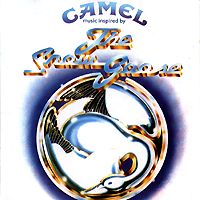
| Andy Ward: | Drums, Vibes, Varispeed Percussion |
| Doug Ferguson: | Bass and Duffle Coat |
| Peter Bardens: | Organ, Mini Moog, Electric Piano, Pipe Organ, Acoustic Piano, ARP Odyssey |
| Andy Latimer: | Electric, Acoustic and Slide Guitars, Flute, Vocals |
The Snow Goose is perhaps Camel's most accessible album.
Recommended for Camel newcomers, and for everybody - not
necessarily for Progressive Rock fans. The Snow Goose is a completely
instrumental concept album, an instrumental piece, gathered together from it's 16
"songs"; some of which featuring an orchestra, two with vocal (but
without lyrics). Once again Camel play complex time meters,
but here the guitar and organ improvisations are held back, in favour of
well-structured solos that fit into the album's concept.
The Janus release of The Snow Goose features story notes on the back
cover. it also doesn't have the "music inspired by" subtitle. The bands
name is printed in pink letters. I believe this the earliest
release of the album.
It is said there is a double-fold version of the LP but I've never seen one.
Mickey Marchello submitted The Original Scenes Descriptions, as they appear on the original Janus release.
Note: A remastered edition of The Snow Goose has been released in 2002 by Deram/Universal. This edition contains additional 24 minutes in five bonus tracks: Flight of the Snow Goose and Rhayader (Single version), Flight of the Snow Goose (Alternative Single Edit), Rhayader Goes to Town and The Snow Goose / Freefall (live at the Marquee Club, 29th October 1974).
| The Snow Goose is based on the novella "The Snow Goose" by Paul Gallico. The story is about a Rhayader, a lonely person who lives in the marshes. One day he finds a wounded Snow Goose, and takes care of her. A little girl, Fritha, is also concerned about the goose, and she and Rhayader become friends. By the season's end the goose heals, and it is sent free. Following this, Rhayader is alone again, as Fritha doesn't come to visit him anymore. Rhayader helps saving people at the battle of Dunkirk, and during the battle the Goose comes back to help. Rhayader is killed in the battle, and the Goose is then named La Princess Perdue. Kids, remember: War is a terrible thing. | |
| It took Latimer and Bardens two weeks of intense work in a solitude cottage in Devon, to write The Snow Goose. | |
| Critics were confused by the lack of lyrics, and The Snow Goose didn't earn Camel much popularity in the US. | |
| While looking up a story for their next album, Bardens had Herman Hesse's "Siddhartha" in mind - according to John Gill. On the other hand, according to John Tracy, he was into Steppen Wolf. Ferguson suggested The Snow Goose and both him and Latimer outvoted Bardens. | |
| It was originally intended to narrate the album, but the idea was dropped. | |
| Paul Gallico's publishers threatened to put a court injunction on the album, and therefore it was entitled "music inspired by". Paul Gallico, a non-smoking author, got a bad impression from the band, due to its name. | |
| Camel worked hard on arranging The Snow Goose live, orchestrated performance. Several attempts were not successful, and one of the better ones is available on A Live Album. | |
| How could anyone play a duffle coat? Doug's duffle coat, mentioned in the credits, was used by Latimer and Ferguson to simulate a flapping of wings (track 13, 00:32) by waving it in the air. | |
| Another The Snow Goose music and story album was officially released by Ed Welch. It is claimed to be a disastrous album. |